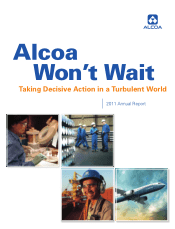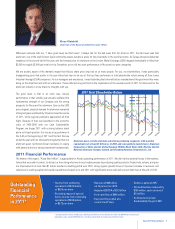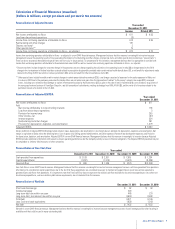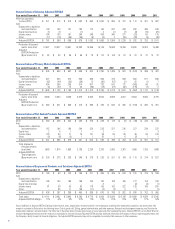Alcoa 2011 Annual Report Download - page 6
Download and view the complete annual report
Please find page 6 of the 2011 Alcoa annual report below. You can navigate through the pages in the report by either clicking on the pages listed below, or by using the keyword search tool below to find specific information within the annual report.
Customer Value Through Innovation
It is important to consider how, in a year of single-digit end market growth, Alcoa achieved a 19 percent revenue increase, primarily from organic
growth. I believe that there were two key drivers of that growth. First, in every one of our key markets – aerospace, automotive, consumer electronics,
packaging, commercial transportation, building and construction, and industrial – customers are seeking cost savings from greater energy effi ciency,
fuel reductions, and recyclability. Second, Alcoa innovation is providing customers the means to achieve those savings.
The rising cost of fuel is one major factor driving aircraft manufacturers to dramatically reduce the weight of their planes, and the lightweight material
of choice remains aluminum. Our advanced aluminum-lithium alloys promise a 10 percent weight reduction and 30 percent life-cycle cost savings, and
we believe they will continue to be the right choice for aircraft, ensuring an aluminum-centric fl eet for at least the next 10 to 15 years.
At the Paris Air Show, Airbus awarded Alcoa a multi-year supply agreement for aluminum sheet and plate products that use
our advanced-generation alloys. This strengthens the Alcoa-Airbus relationship across virtually all Airbus commercial aircraft
programs, allowing us to provide a wide range of products from fasteners to fuselage panels to Airbus’ newest wing skins.
We also continue to build on our strong relationship with Boeing. At the air show, we also announced a partnership with
Spirit AeroSystems to jointly produce a revolutionary fuselage panel for commercial airliners that uses Alcoa’s third-generation
Al-Li 2060 aluminum-lithium alloy – lighter, lower-cost, and with lower production risks than composite-intensive aircraft.
Innovations from Alcoa’s downstream manufacturing businesses also play a vital role in improving aircraft effi ciencies. For instance, Alcoa’s Power
and Propulsion business produces advanced cooling designs and thermal coatings that allow jet engine original equipment manufacturers (OEMs) to
increase turbine operating temperatures, reduce weight and emissions, and improve effi ciencies, while avoiding potential durability issues from these
harsher operating conditions. This means jet engine manufacturers can build hotter-running engines that have greater fuel effi ciencies and reduced
nitrogen oxide emissions.
As a result of our innovations in fastener solutions, we have increased our fastener content in new aerospace platforms versus legacy programs, and
have boosted our content of new patented products. For instance, we developed a range of fasteners for the Boeing 787 and the Airbus 350 to integrate
the function of lightning strike management with the structural fastening of the airframe. Combined with our content on the Boeing 767, the new
fasteners on these three platforms will generate over $120 million in increased revenue by 2013.
Extrusions made from Alcoa’s third-generation aluminum-lithium alloys are currently fl ying on fuselage and wing applications for large commercial
airframes, and our segmented die forgings coupled with our proprietary cold-worked, stress-relieving process are used to deliver the largest forgings
in the industry, including the aluminum inner rear spar of the A380. This monolithic piece saves Airbus weight and cost and improves performance.
In the industrial gas turbine market, OEMs are looking for effi ciencies, reduced nitrogen oxide, and an improvement in the number of start-stop
cycles and operating hours. Our Alcoa Power and Propulsion business has developed an advanced platform core technology that allows us to direct
cooling air in a gas turbine blade where it wasn’t possible before, allowing the industrial gas turbine to run at higher temperatures while keeping the
platform temperatures below the oxidation point. The resulting higher fi ring temperature yields greater turbine effi ciency, increased power output, and
lower emissions.
Alcoa is also driving a greater use of aluminum in the global ground transportation and automotive industries as they seek fuel cost savings and
reduced emissions from weight reduction. Since 1990, the increased use of aluminum in the world’s vehicle fl eet has avoided putting one billion
tons of greenhouse gas (GHG) emissions into the atmosphere and saved more than 84 billion liters of gasoline – results welcomed by regulators,
manufacturers, and consumers alike. As the automotive sector seeks greater fuel effi ciency, we see a potential for over 10 million metric tons of new
sales, with an expected growth of 7.5 times today’s consumption in global automotive sheet in fl at-rolled products.
Since the U.S. CAFE (Corporate Average Fuel Economy) regulations require an average of 35.5 miles per gallon (mpg) for automobiles by 2016 and may
go up to 54.5 mpg by 2025, the use of aluminum in cars manufactured for the U.S. market will grow dramatically. To meet that demand, in September we
4
Most of the 1,700 new orders at the 2011 Paris Air Show consisted of Airbus 320neo and Boeing 737 MAX narrow body planes.



















